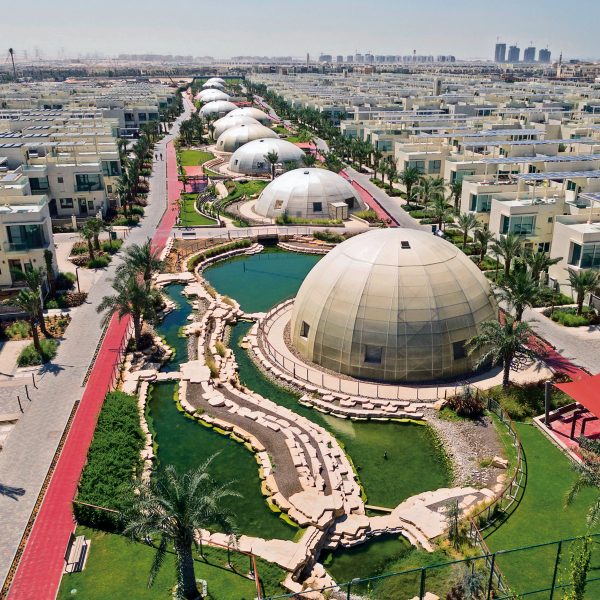UAE’s Green Building Revolution: Smart Cities & More

The UAE is one of the dream destinations for real estate investors from across the globe. The country has a booming real estate industry that generates nearly 5.5% of the total GDP. Statista estimates also show that the value of the real estate market in the country is projected to reach US$0.69tn in 2023, which shows how well the industry has recovered post-pandemic.
While the real estate industry’s continued growth will positively impact the UAE’s economy, it is equally important to consider its impact on the nation’s sustainability initiatives and Net Zero Emissions 2050 efforts. As the country is working towards an eco-friendly smart city design by implementing massive changes in many sectors, it is vital to encourage and uphold the same ideals in the real estate industry.
Before we dive into how the UAE is faring in terms of its green building programs and energy efficiency, let’s take a moment to understand how buildings impact our environment.
Green Buildings: Where we stand today
According to the International Energy Agency (IEA), 30% of global energy consumption and 26% of all energy-related emissions worldwide are from the operation of buildings. To reduce the overall energy consumption in buildings, most countries have minimum performance standards and building energy codes in place, focusing primarily on the efficient use of energy and the introduction of renewable energy technologies right from the time of design and construction. Apart from ensuring reduced emissions and energy efficiency, green buildings are also cost-efficient in the long run and improve the overall air quality inside and around the structure.
However, it is important to accelerate these initiatives within the next decade to get on track with Net Zero Emissions. Back in 2010, the UAE announced green-building standards for the real estate development sector. The same year, Abu Dhabi introduced the Estidama rating system for buildings, making it the mandatory standard for new buildings, while Dubai passed its green-building regulations. A few years down the line in 2018, Ajman also joined the eco-revolution by permitting the construction of new buildings only if they complied with the green building regulations.
As a result of these regulations, Abu Dhabi had its first net-zero energy building in 2017 in Masdar City. The entirety of the city is also meant to be a prime example of sustainable urban development, with innovation and community living at its core. This smart city is estimated to be home to 45,000 to 50,000 people and 1,500 businesses upon completion and will be an eco-friendly haven of the future. Also, in June 2022, Masdar City started the construction of a City Square which includes a net-zero energy commercial headquarters building and six additional LEED Platinum and WELL Gold buildings, all of which are expected to be completed by 2024.
The vision behind such eco-friendly smart cities is indeed impressive. As the first country in the GCC to commit to net zero, these initiatives and continuous efforts will certainly drive sustainable real estate development. As of 2021, the UAE has 869 green-rated buildings, ranking as the 14th highest concentration worldwide. Some of the most sustainable LEED-certified buildings in the country include-
- The Irena building, Masdar
- Lattice-Domed Parliament Building, Abu Dhabi
- The Sustainable City, Dubai
- Pacific Controls Headquarters Building, Dubai
- Sheikh Khalifa Medical City, Abu Dhabi
- Siemens Headquarters, Abu Dhabi
- Midfield Terminal, Abu Dhabi International Airport
- Aldar Market, Abu Dhabi
- Twin Al Bahr Towers, Abu Dhabi
Shifting Consumer Interest in Green Buildings
Green buildings are the future, and the consumers think so too!
According to reports, 80% of real estate investors in the UAE are prioritizing sustainable living, with 70% of them willing to pay a premium for green buildings. Global data also shows that millennials and Gen Z investors constitute 90% of the demographics who are willing to actively reduce their carbon footprint, which includes investing in sustainable, eco-friendly properties.
As climate change has become a significant priority among today’s generations, putting sustainability at the core of their real estate investments is not only thoughtful but also a smart financial decision.
Can we rethink plastics for Green buildings?
As we explore the green building trends in the UAE, we cannot stop wondering if recycled plastics can be of any help. At the end of the day, our mission at There’s More to Plastic is to build a community that is committed to recycling their plastic bottles and other recyclable materials and helping reduce our carbon footprints.
Interestingly, experts in the region are open to exploring the possibility of using recycled plastics for the construction of green buildings. Most traditional building materials such as brick, cement, and steel have a significant environmental footprint as their manufacture, transportation, and installation is carbon intensive. If architects and engineers can alternate these materials using recycled plastics, it can not only make the concrete “greener” but also ensure reduced emissions.
Today, recycled plastics are more viable and readily available in many countries across the globe. However, the recycling industry is still an underdeveloped sector in the UAE as well as in other GCC nations. Increased investments to develop and commercialize the existing plastic recycling technologies will help bring this valuable material into the construction supply chain, potentially revolutionizing the industry.
What can you do to help?
As a first step, we invite you to take a pledge to recycle plastic bottles regularly. To learn more about the importance of plastic recycling and how to recycle plastic bottles locally, follow us on socials today.
Green building trends are sure to change the face of our country. If you are one among the thousands who are now choosing to follow a more sustainable and eco-friendly lifestyle- from where you live to what you do daily- start with plastic recycling.
Sources:
https://www.statista.com/outlook/fmo/real-estate/united-arab-emirates
https://www.iea.org/energy-system/buildings
